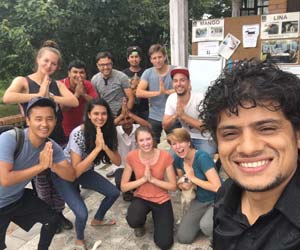|
 When booking this trip, I thought, “Two months? That’s nothing!” When I arrived, I thought, “Two months? There’s no way I can last that long!” Now that I’ve reached the end of my two months, there are tears in my eyes at the thought of leaving. I’ve done all the things I worried I couldn’t. I learned how to take the insane public transport system. I can cross the road like a pro. I can safely restrain dogs twice my size. I’m the only one who’s traveled here that I’ve met who hasn’t gotten sick even once. I still suck at arguing prices, but hey, win some, lose some. When booking this trip, I thought, “Two months? That’s nothing!” When I arrived, I thought, “Two months? There’s no way I can last that long!” Now that I’ve reached the end of my two months, there are tears in my eyes at the thought of leaving. I’ve done all the things I worried I couldn’t. I learned how to take the insane public transport system. I can cross the road like a pro. I can safely restrain dogs twice my size. I’m the only one who’s traveled here that I’ve met who hasn’t gotten sick even once. I still suck at arguing prices, but hey, win some, lose some.
There are so many things about this country that I swore I would never get used to that I now barely register. There’s the spicy food that I dreaded but now think I’ll miss. There’s the omnipresent feeling of being stared at that I’ve learned to ignore. There’re the plywood-esque beds that I now find comfy and the constant barking of dogs that now almost lulls me to sleep (Okay that’s not completely true, but I was getting there). There’s the isolating feeling of almost never knowing what anyone around you is saying that has become mostly background noise. The only think I think I would never have gotten used to is seeing cows in the middle of the street. Chickens? Fine. Dogs? Whatever. Goats? Makes sense. Cows? Nope. Always makes me do a double-take.
I am so grateful for the amazing work experiences I have received here. It wasn’t a light-hearted job, I saw some pretty horrific things, but those experiences were always tempered with hope. You can’t see how hard your fellow staff and volunteers work and how happy the rescues are and not feel hopeful for the future of Kathmandu’s stray population. I’m especially grateful for all the help I’ve received in getting my dog home, and I know how easy I’ll rest once he’s safe on American soil.
I thought I’d end my final post with a story about the final trip I took out of Kathmandu. I originally wasn’t going to go to Pokhara, but I really wanted to go with the group of people who were planning on travelling there. So I hopped on a bus. Eight hours later, we were in a city that felt weirdly like suburban Minnesota to me. When we woke up that next morning, I saw the Himalayas for the first time in my nearly eight weeks in Nepal. The feeling that seeing those massive peaks gave me was really unexpected. I actually felt extremely unsettled. There’s something really insidious about them, the way that they’re always there, surrounding you, but you can’t see them. Eeriness or not, they were absolutely spectacular, and I was glad to glimpse them. Later that day we did something I really didn’t expect myself to do: paragliding. It was a cloudy day, and we had to wait at our jumping point for a while for the sky to clear. At one point it began to rain, and we worried that it would be cancelled. Despite being nervous initially, I was really disappointed when we started packing up. Then, out of nowhere, the skies cleared. People started jumping one after another, looking like a very large and colorful flock of birds. When my guide, who referred to me as “Mandala”, told me to start running, we took off. Suddenly the ground beneath my feet fell away, and we were airborne. Despite the height, it was an extremely relaxing experience. And, of course, the view was amazing. We wrapped up the journey at a nice restaurant and disembarked the next morning.
There are so many things I’m looking forward to at home: friends and family, familiar food, actually comfy furniture, and returning to school. But leaving a place you’ve acclimated to is never easy, and I’m already bracing myself for the culture shock upon my return. While I wouldn’t go as far as to say that my time here has completely changed my outlook on life or left me enlightened, I hope to never be as pretentious as that, but I have learned a lot. I’ve learned how lucky I am, what’s most important to me, and that I’m capable of so much more than I would have thought. Nepal is a colorful, diverse country full of resilient and warm people, and I’m so glad I got to experience its beauty and use my gifts to contribute to it. And I am so overwhelmingly thankful for the friends I’ve made here. I’ve always said that, for me, it’s less about what I’m doing and more about who I’m with. I’m so glad to have found so many great people to share my experiences with. I’m hopeful that I’ll only find its people and animals happier and healthier when I return. Until next time, Nepal.
See Madeline's other posts from Nepal HERE
|